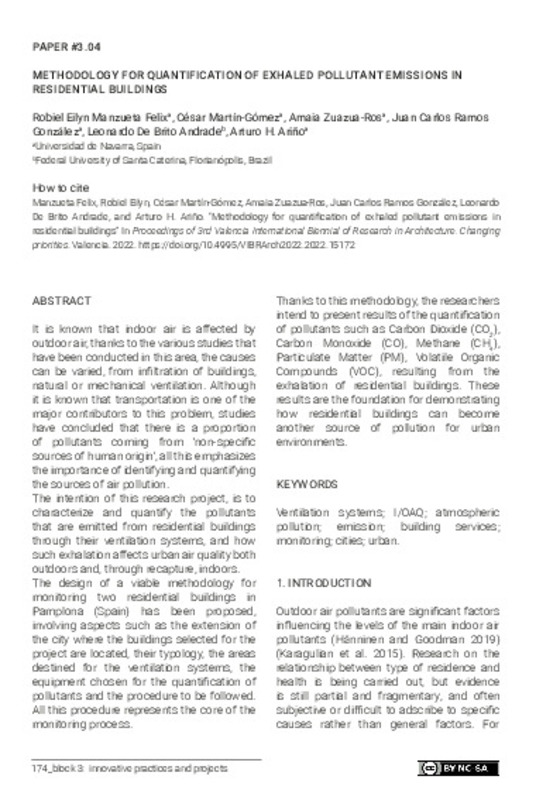JavaScript is disabled for your browser. Some features of this site may not work without it.
Buscar en RiuNet
Listar
Mi cuenta
Estadísticas
Ayuda RiuNet
Admin. UPV
Methodology for quantification of exhaled pollutant emissions in residential buildings
Mostrar el registro sencillo del ítem
Ficheros en el ítem
| dc.contributor.author | Manzueta Felix, Robiel
|
es_ES |
| dc.contributor.author | Martín-Gómez, César
|
es_ES |
| dc.contributor.author | Zuazua-Ros, Amaia
|
es_ES |
| dc.contributor.author | Ramos González, Juan
|
es_ES |
| dc.contributor.author | De Brito Andrade, Leonardo
|
es_ES |
| dc.contributor.author | Ariño, Arturo
|
es_ES |
| dc.date.accessioned | 2023-12-18T10:30:42Z | |
| dc.date.available | 2023-12-18T10:30:42Z | |
| dc.date.issued | 2023-05-22 | |
| dc.identifier.isbn | 9788413960265 | |
| dc.identifier.uri | http://hdl.handle.net/10251/200824 | |
| dc.description.abstract | [ES] It is known that indoor air is affected by outdoor air, thanks to the various studies that have been conducted in this area, the causes can be varied, from infiltration of buildings, natural or mechanical ventilation. Although it is known that transportation is one of the major contributors to this problem, studies have concluded that there is a proportion of pollutants coming from 'non-specific sources of human origin', all this emphasizes the importance of identifying and quantifying the sources of air pollution.The intention of this research project, is to characterize and quantify the pollutants that are emitted from residential buildings through their ventilation systems, and how such exhalation affects urban air quality both outdoors and, through recapture, indoors.The design of a viable methodology for monitoring two residential buildings in Pamplona (Spain) has been proposed, involving aspects such as the extension of the city where the buildings selected for the project are located, their typology, the areas destined for the ventilation systems, the equipment chosen for the quantification of pollutants and the procedure to be followed. All this procedure represents the core of the monitoring process.Thanks to this methodology, the researchers intend to present results of the quantification of pollutants such as Carbon Dioxide (CO2), Carbon Monoxide (CO), Methane (CH4), Particulate Matter (PM), Volatile Organic Compounds (VOC), resulting from the exhalation of residential buildings. These results are the foundation for demonstrating how residential buildings can become another source of pollution for urban environments. | es_ES |
| dc.description.sponsorship | The Spanish Ministry of Science, Innovation and Universities for funding the research project ‘Quantifying pollutants originated by the exhalation of buildings in urban environments’n. PID2019-104083RB-I00. | es_ES |
| dc.format.extent | 10 | es_ES |
| dc.language | Inglés | es_ES |
| dc.publisher | Editorial Universitat Politècnica de València | es_ES |
| dc.relation.ispartof | Proceedings - 3rd Valencia International Biennial of Research in Architecture, VIBRArch | |
| dc.rights | Reconocimiento - No comercial - Compartir igual (by-nc-sa) | es_ES |
| dc.subject | Ventilation systems | es_ES |
| dc.subject | I/OAQ | es_ES |
| dc.subject | Atmospheric pollution | es_ES |
| dc.subject | Emission | es_ES |
| dc.subject | Building services | es_ES |
| dc.subject | Monitoring | es_ES |
| dc.subject | Cities | es_ES |
| dc.subject | Urban | es_ES |
| dc.title | Methodology for quantification of exhaled pollutant emissions in residential buildings | es_ES |
| dc.type | Capítulo de libro | es_ES |
| dc.type | Comunicación en congreso | es_ES |
| dc.identifier.doi | 10.4995/VIBRArch2022.2022.15172 | |
| dc.relation.projectID | info:eu-repo/grantAgreement/AEI/Plan Estatal de Investigación Científica y Técnica y de Innovación 2017-2020/PID2019-104083RB-I00/ES/CUANTIFICACION DE PARAMETROS CONTAMINANTES DE LA EXHALACION DE LOS EDIFICIOS EN ENTORNOS URBANOS/ | es_ES |
| dc.rights.accessRights | Abierto | es_ES |
| dc.description.bibliographicCitation | Manzueta Felix, R.; Martín-Gómez, C.; Zuazua-Ros, A.; Ramos González, J.; De Brito Andrade, L.; Ariño, A. (2023). Methodology for quantification of exhaled pollutant emissions in residential buildings. Editorial Universitat Politècnica de València. 174-183. https://doi.org/10.4995/VIBRArch2022.2022.15172 | es_ES |
| dc.description.accrualMethod | OCS | es_ES |
| dc.relation.conferencename | 3rd Valencia International Biennial of Research in Architecture, VIBRArch | es_ES |
| dc.relation.conferencedate | Noviembre 09-11, 2022 | es_ES |
| dc.relation.conferenceplace | Valencia, España | es_ES |
| dc.relation.publisherversion | http://ocs.editorial.upv.es/index.php/VIBRArch/VIBRArch2022/paper/view/15172 | es_ES |
| dc.description.upvformatpinicio | 174 | es_ES |
| dc.description.upvformatpfin | 183 | es_ES |
| dc.type.version | info:eu-repo/semantics/publishedVersion | es_ES |
| dc.relation.pasarela | OCS\15172 | es_ES |
| dc.contributor.funder | Agencia Estatal de Investigación | es_ES |








